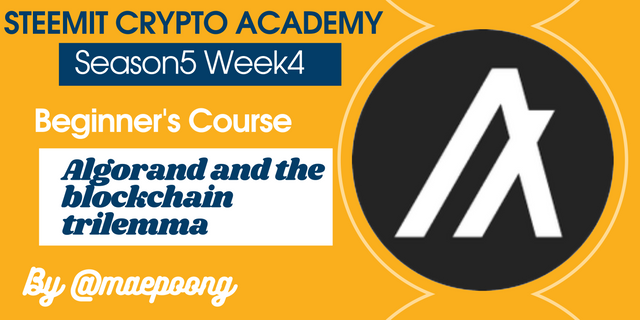Algorand and the blockchain trilemma - Crypto Academy / S5W4 - Homework post for nane15
1. What is the Algorand blockchain?
Algorand is a decentralized network on a blockchain platform. This platform was born in June 2019 by computer expert, professor Silvio Micali. He built Algorand with the aim of solving the difficult problems of blockchain at the time, namely speed, security, and decentralization. It is a platform for new businesses and projects worldwide, enabling them to operate in a fully decentralized economy. In addition, Algorand has an open source code, allowing all members to participate in improving and improving the platform system.
Algorand has created a new consensus protocol called Pure Proof Of Stake (PPOS) based on the old consensus protocol. This protocol will ensure that network security will be tied to the honesty of the majority.
Although derived from the Proof Of Stake (POS) protocol, Pure Proof Of Stake has some differences from Delegated Proof Of Stake (DPOS), Liquid Proof Of Stake (LPOS) and Bonded Proof Of Stake (BPOS). ).
In particular, PPOS is built on the Byzantine Agreement (BA), which allows the user's influence on the creation of new blocks to be fully proportional to their holdings in the system, as well as the number of tokens.ALGO they hold.
2. What is PPOS?
PPOS (Pure Proof Of Stake) is Algorand's consensus mechanism. guarantees security and speed with full participation in a fully decentralized network. Since blocks are confirmed in seconds, Algorand's transaction results are comparable to high-value payment systems and financial networks. Algorand is the first blockchain to offer instant closing of transactions. Absolutely no forking or uncertainty.
The Algorand cryptocurrency PPoS consensus mechanism uses a two-step block production process consisting of a proposal and a vote.
Each participating node is coordinated by a relay node, which is another type of node in the Algorand network, which facilitates communication between participating and non-participating nodes directly in proposals or voting.
In the proposal phase, a bloc leader to propose the current bloc is selected. The block leader randomly selects nodes, but is selected via Algorand's Verifiable Random Function (VRF), a proven random mechanism that is weighted according to the relative size of its members.
Block leaders are secretly assigned via their own private membership key. This means that only the block leader knows that it has been assigned to block the proposal. VRF provides cryptographic proofs that allow block readers to easily and verifiably prove the current state of the block leader.
3. Explain the advantages and disadvantages of PPoS.
PPoS has many advantages, including:
Cost-effective and precise from the start, supporting complex applications that require speed, scale, finality and security.
Unbranched as only one block can have a signature requirement threshold to be certified in a given round.Self Selection All users are randomly, surreptitiously and persistently selected to participate in the consensus protocol – there is no authorized user or permanent committee responsible for recommending block recommendations in Algorand.
User Switching Participants change each round of block selection to protect the network from attackers – for each round, each group of participants is random and independent of the previous participant.
Groups, individuals or institutions cannot control the network on the block, theoretically, because of their authority to choose the user who is in charge of proposing and validating the block so that security is maintained.
Removes the challenges of decentralization, scalability, and security that have been technical barriers to mainstream blockchain adoption for years. System development is now possible on a reliable and stable platform.
The basic drawback of PPoS may be that it is too young so it is difficult to detect while its sibling such as PoS and PoW have been implemented for a long time so that it is easier to detect deficiencies, so I conclude that PPos has very few shortcomings.
The small reward received after validating the block is also PPoS weakness, then there is no severe punishment for criminals on this network is also PPos weakness.
4. Do you think Algorand really broke the blockchain trilemma? Explain your answer.
Is the blockchain Trilemma (decentralization, security, and scalability) that Ethereum creator Vitalik Buterin talks about really impossible to crack?
So Algorand was born to answer this question.
Algorand is a permissionless blockchain-based virtual asset platform, developed by Silvio Micali, an authority on zero-knowledge evidence and also a recipient of the Turing Prize, the so-called Nobel Prize in computer science. It was developed by a professor at MIT in 2019.
The answer to this question is of course yes for several reasons:
Algorand removes the challenges of decentralization, scalability, and security that have been technical barriers to mainstream blockchain adoption for years. System development is now possible on a reliable and stable platform.
In Algorand, one block producer is chosen at random from all Algorand token holders (ALGO), and the probability of being selected as a generator increases in proportion to the number of tokens held. Then, from all token holders, 1,000 block validators are randomly selected once again, and serve to check if the generated block has been generated correctly.
Algorand uses 'cryptographic sorting (or self-selection)' technology based on digital signatures and hash functions, so energy consumption is very low, and only the party with the private key can know who was selected.
In this case, because the list of block generators or block verifiers is not exposed beforehand, it is possible to avoid targeted attacks, cash purchases, and collusion in advance, making it more secure than existing Proof of Stake (PoS) methods.Apart from that, there are no rewards or slashes like the 'Bonded PoS' of Ethereum 2.0 as it doesn't require much effort for block generation or verification. Algorand calls it 'PPoS (Pure-proof of Stake)
So the blockchain trilemma said by Ethereum founder Vitalik buterin "A blockchain can only have two of the three (Decentralization, Security, and Scalability)" does not apply to Algorand.
Therefore I conclude that Algorand can really solve the Trilemma as we have discussed above.
5. Do you think PPoS is better than PoW? Explain your answer.
Before I answer this question, of course, we must first know what PoW is so that we can compare it with PPoS, well now we will discuss a little about PoW.
PoW consensus algorithm - short for Proof of Work : is a consensus algorithm introduced by Bitcoin and popularly used by many other altcoin cryptocurrencies. Simply put, this process is known as "mining" and the nodes on the network are "miners".
PoW requires miners to solve complex cryptographic problems, thus validating blocks on the blockchain, and then receiving rewards in the form of new coins or tokens whereas PPoS doesn't need that because to apply for new blocks it will be chosen randomly.
As the name suggests, you have to work to get paid/rewarded.
Engine supply and engine power
Solve complex algorithms with power consumption. Usually, the more machines, the more powerful and power-consuming it is to solve math problems faster and more accurately, whereas PPoS does not require power because it doesn't have to solve algorithms so any power is not required.
Unlike proof-of-work (PoW) protocols such as Bitcoin, Algorand's Proof of Stake (PPoS) protocol does not require participants to solve a cryptographic puzzle to propose or verify a block, this is also an advantage that PPoS has, so it can be said that PPOS is much better than PoW.
Finally, I conclude that PPoS is better than PoW because the system costs a lot to mine while PPOS doesn't.
6. Do you think PPoS is better than PoS? Explain your answer.
The answer to this question is of course yes, PpoS is better than PoS for several reasons, the most basic reason is that PoS was created to cover the shortcomings that exist in PoW so that PoS is better than PoW while the presence of PPoS is to cover the shortcomings that exist in PoW and PoS. Therefore we can conclude that the presence of PPoS is able to overcome all the problems that exist in the blockchain so that for now PPos is much better than PoW and PoS.
To be clear, I will explain a little about PoS, the presence of Pos is able to overcome the scalability problems that exist in PoW at the same time PoS has to sacrifice decentralization which is one of the three concepts in blockchain then the developers sparked a new consensus, namely PPoS to cover the shortcomings of existing decentralization. in PoS.
So from the above review we can conclude that the presence of an algorithm that uses PPoS consensus is able to solve the Trilemma blockchain that cannot be solved by PoW or PoS, because PoS can only solve scalability but must leave decentralization. So PPoS is much better Pos for now.
7. Explore and explain ALGO transactions using algoexplorer.io ( Screenshots required)
After I explored algoexplorer.oi it looks like the screenshot below :
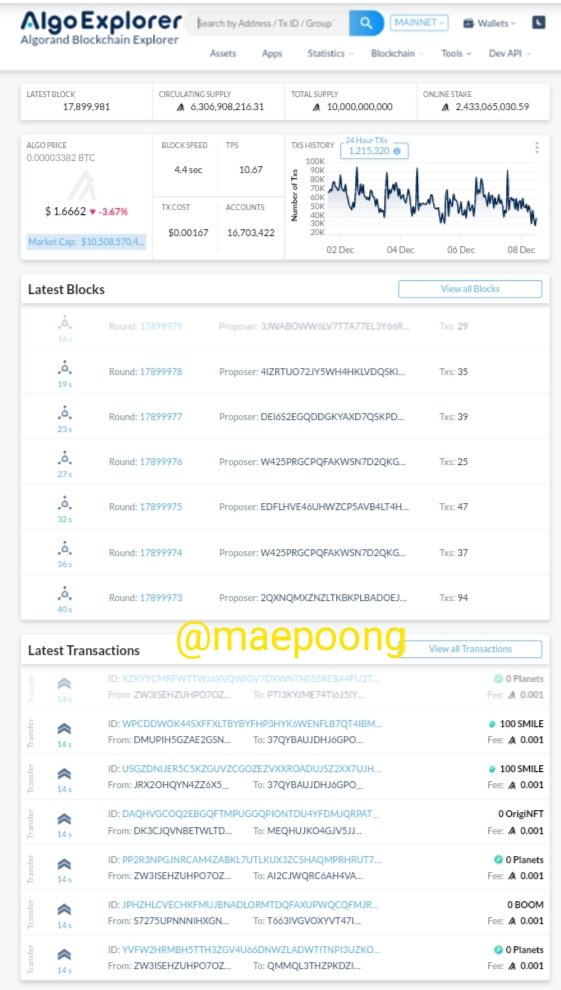
Source Algoexplorer.io
The next step then we look at the display, namely: the last block, circulating supply of ALGO, total supply, amount in Stake, token price, block creation speed, creation fee and number of user accounts.
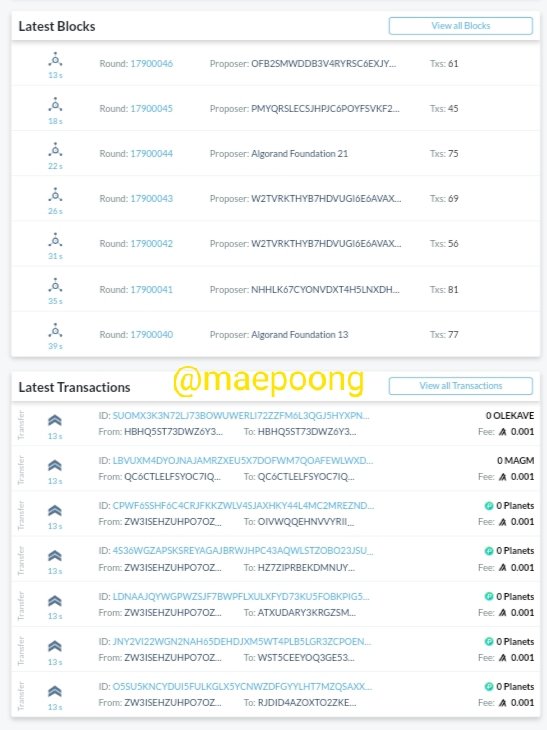
Source Algoexplorer.io
Here we only select one of the most recent transactions.
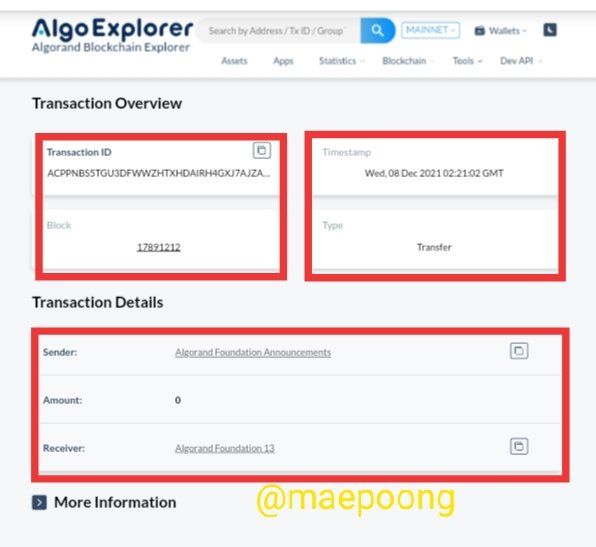
Source Algoexplorer.io
The next step is we click on one of the latest transactions, then we can see the detailed history, such as, Transaction Id, Timestamp, Block, and Type.
8. Perform ALGO price analysis from the beginning of the year to the present. Via graphics (screenshot required.)
Below I analyze the price of ALGO On the CoinMarketCap chart.
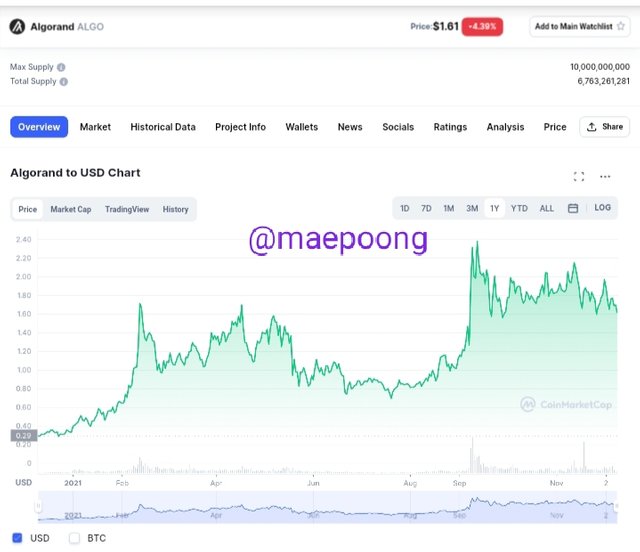
Source CoinMarketCap
As shown in the screenshot above, the price of ALGO moved from $0.29 then in early February the day started to climb from $0.80 and peaked to $1.75 then fell again around $1.00 to $1.45.
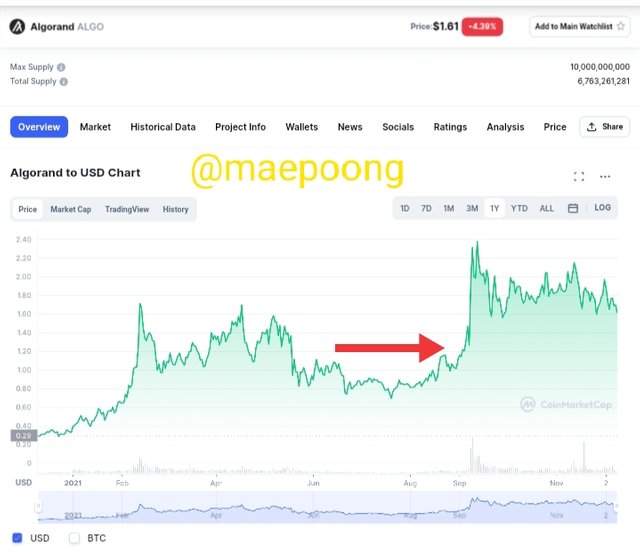
Source CoinMarketCap
Then in June to September the price only ranged from $1.00 to $1.40 then rose again.
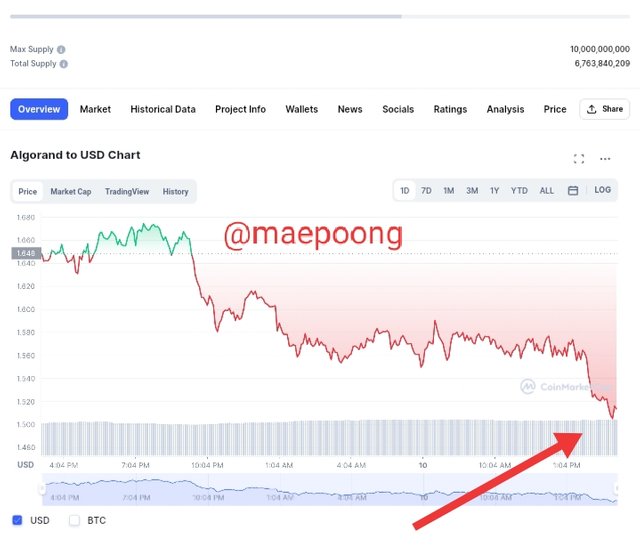
Source CoinMarketCap
Today's last price on the CoinMarketCap chart $1.50 this is my analysis using CoinMarketCap.
conclusion
A series of actions on the platform enable increasingly sophisticated applications. Algorand takes his family very seriously. Dispersion of security speed. So far, I think there is a healthy balance in terms of this blockchain trilemma. As new extensions are added to the platform, this task is also made easier with the advent of PPOS. At the same time, platform scaling is a necessary and inevitable task.
So the development and improvement of the blockchain platform is very important in this race. At the same time maintaining their decentralized nature is also important , otherwise blockchains will lose their most attractive properties. (Sensorship, transparency, no possibility of data manipulation or tolerance for security). So it's a very difficult task. I think Algo Rand will go to the right, but the competition is also maintained.
